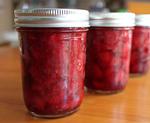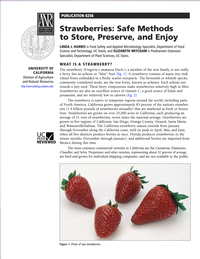Strawberries
Strawberries: Safe Methods to Store, Preserve and Enjoy
This is an introduction to UCANR Publication 8256, entitled "Strawberries: Safe Methods to Store, Preserve, and Enjoy", dated March 2007. The entire publication is available for free online, here. Please refer to it for additional information.NOTE: Research on food preservation is ongoing - recommendations may change. Make sure your preservation information is always current. Always follow up-to-date, tested guidelines and recipes from reliable sources.
The strawberry (Frageria x.ananassa Duch.), a member of the rose familily, is not really a berry, but an achene or ‘false’ fruit. A strawberry consists of many tiny individual fruits embedded in a fleshy scarlet receptacle. The brownish or whitish specks, commonly considered seeds, are the true fruits, known as achenes. Each achene surrounds a tiny seed. These berry components make strawberries relatively high in fiber.
Nutrition – Strawberries are an excellent source of vitamin C, a good source of folate and potassium and are relatively low in calories.
Selecting Strawberries at the Grocery Store – Select strawberries that have a bright, glossy appearance and maximum red color development. Avoid fruit with signs of spoilage, shriveling, mushiness, or a dull color.
Selecting Strawberries from Your Home Garden or Pick-Your-Own Site – Strawberries do not ripen after they are harvested, so it is important to pick the fruit at the right stage of maturity. Pick when the berry surface is fully red, without green or white areas. This fruit will contain the maximum sweetness and flavor. Strawberries that are deep red and dull in appearance are overripe and may be very soft.
Harvest strawberries by gently snapping the pedicel (stem) from the plant. Take care to avoid bruising the berries. Cool the freshly picked berries as soon as possible after harvesting, and store the fruit in the refrigerator until used.
Storing – The optimum storage temperature for strawberries in the home is 32° to 36°F. Store the fruit in the crisper drawer of your refrigerator keeping them in their plastic container or put in a partially opened plastic bag to maintain high humidity. Strawberries can only be stored for up to 7 days under optimum conditions - depending on how ripe the fruit was when purchased or picked.
Washing – Do not wash berries until just before eating or preserving. Washing will add moisture and cause the berries to spoil more rapidly.
SAFETY TIPS FOR HANDLING FRESH STRAWBERRIES
- Wash your hands with soap and water before and after preparing produce. Wash cutting tools and cutting surfaces before and after to prevent bacterial contamination.
- Just before eating or preserving, rinse strawberries thoroughly under cool running water gently rubbing each berry, drain in a clean strainer, pat dry with a clean paper towel. Washing in a sink of water is not recommended since it may promote the spread of potential bacterial contamination.
- Sort fruit, discarding unripe, overripe or defective fruit. Remove and discard the green cap (leafy part) before slicing. Cover or refrigerate cut fruit if not eaten within 2 hours.
PRESERVATION METHODS: STRAWBERRIES
FREEZING STRAWBERRIES – Select firm, fully ripe, red berries and wash them according to the instructions listed above. Strawberries may be frozen whole, sliced, crushed or pureed, depending on their intended use in recipes. Read more…..
DRYING STAWBERRIES – Strawberries are good candidates for drying/dehydrating. Preparation for drying follows the same process as for freezing with regards to washing and slicing. The secret to dehydrating strawberries successfully is to control the temperature and air circulation.
Dehydration Methods:
Oven Drying – not usually recommended since it takes so long: about 18 hours.
Sun drying
Dehydrator Drying
Microwave Drying – NOT recommended.
Conditioning dried strawberries peel – Since strawberries are generally eaten without being rehydrated, they should not be dried to the point of brittleness. They make an excellent snack. Read more….
Packaging and Storage – Dehydrated strawberries require very little storage space. Sealed plastic bags or airtight jars will suffice. Read more…
STRAWBERRY FRUIT LEATHER – Fruit leathers are home made dried fruit rolls. They are made by pouring pureed fruit onto a flat surface and drying. When dried, the product is pulled from the surface and rolled. Strawberries made an excellent fruit leather. For more on how to do this, read…
CANNING JAMS & JELLIES
Jams, jellies and fruit spreads are simple and rewarding ways to preserve strawberries.
Refer to UCANR 8256 for a Strawberry Jelly recipe and additional information about safe methods to store, preserve and enjoy strawberries.
Our Food Resources Page has other sources of information and tested recipes. Utah State University Cooperative Extension has a publication dedicated to preserving berries: “Preserve the Harvest: Berries”:
http://extension.usu.edu/files/publications/publication/FN_2005_Harvest-09.pdf
The following is a sampling of strawberry recipes from the National Center for Home Food Preservation.

Strawberry Jam:
http://nchfp.uga.edu/how/can_07/strawberry_jam_powder.html
Strawberry Preserves:
https://nchfp.uga.edu/how/can_07/strawberry_preserves.html
Rhubarb-Strawberry Jam:
http://nchfp.uga.edu/how/can_07/rhubarb_strawberry_jam_liquid.html
Strawberry-Kiwi Jam:
http://nchfp.uga.edu/how/can_07/strawberry_kiwi_jam.html

